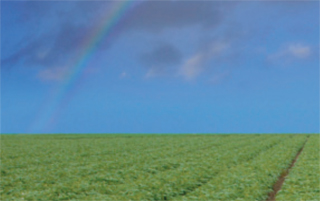Last year was a page-turner of seasonal weather events from frost, intense summer storms, a hurricane, and a blizzard that pounded New Jersey’s terrain. Coastal homes and businesses, and pretty much the entire highly urbanized northern half of the state, were hard hit.
Contrary to belief, however, the inland southern portion escaped much of the comprehensive brunt, sparing the premier growing region of fresh fruits and vegetables. New Jersey’s nickname, “the Garden State,” is not a nostalgic Colonial remnant, but a declaration of modern day bounty.
Wicked Weather
“The storm in June, with all that wind and rain, was far worse than Hurricane Sandy,” reported grower Shirley Kline, president of the Cumberland County Board of Agriculture, and director for the New Jersey Farm Bureau. Hurricane Sandy did not impact the agricultural infrastructure as feared. Given the storm hit near the end of the season, luckily, as Al Murray, New Jersey’s Assistant Secretary of Agriculture, says, “most crops were harvested by then.”
The darkest cloud for the industry has always been uncontrollable: Mother Nature. “Weather affects more than just quality and quantity; it affects the marketing system,” explains Murray, referring to the steady succession of ripening crops, starting in Florida and progressing northward. “A normal spring means demand stays steady,” he says.
It can also set the stage for a jackpot season. In the case of blueberries, “Timing-wise, we can catch the Fourth of July and meet the demands of that [enormous] market,” explains Tim Wetherbee, chair of the New Jersey Blueberry Industry Advisory Council, and sales manager for Diamond Blueberry Inc., in Hammonton.
However, when weather events interfere with this natural progression, “product gets backed up all over the place,” Murray observes, in which case the industry faces a rash of new problems including gluts, shortages, and sharp price fluctuations.
Plentitude
When not dodging hurricanes, South Jersey growers mine fruit and vegetable gold from eight major producing counties: Atlantic, Burlington, Camden, Cape May, Cumberland, Gloucester, Ocean, and Salem. Fruit-wise, the Garden State is most invested in apples, blueberries, cranberries, and peaches, with a combined value of $178.8 million for 2012. Its production value ranks third in the country for cranberries and peaches, and sixth for blueberries, according to the U.S. Department of Agriculture (USDA) National Agricultural Statistics Service.
At the summit of the state’s nearly $200 million annual vegetable industry are tomatoes and bell peppers (though both are botanically a fruit), sweet corn, and cucumbers. Nationwide, New Jersey is third and fourth in fresh spinach and bell peppers, respectively.



